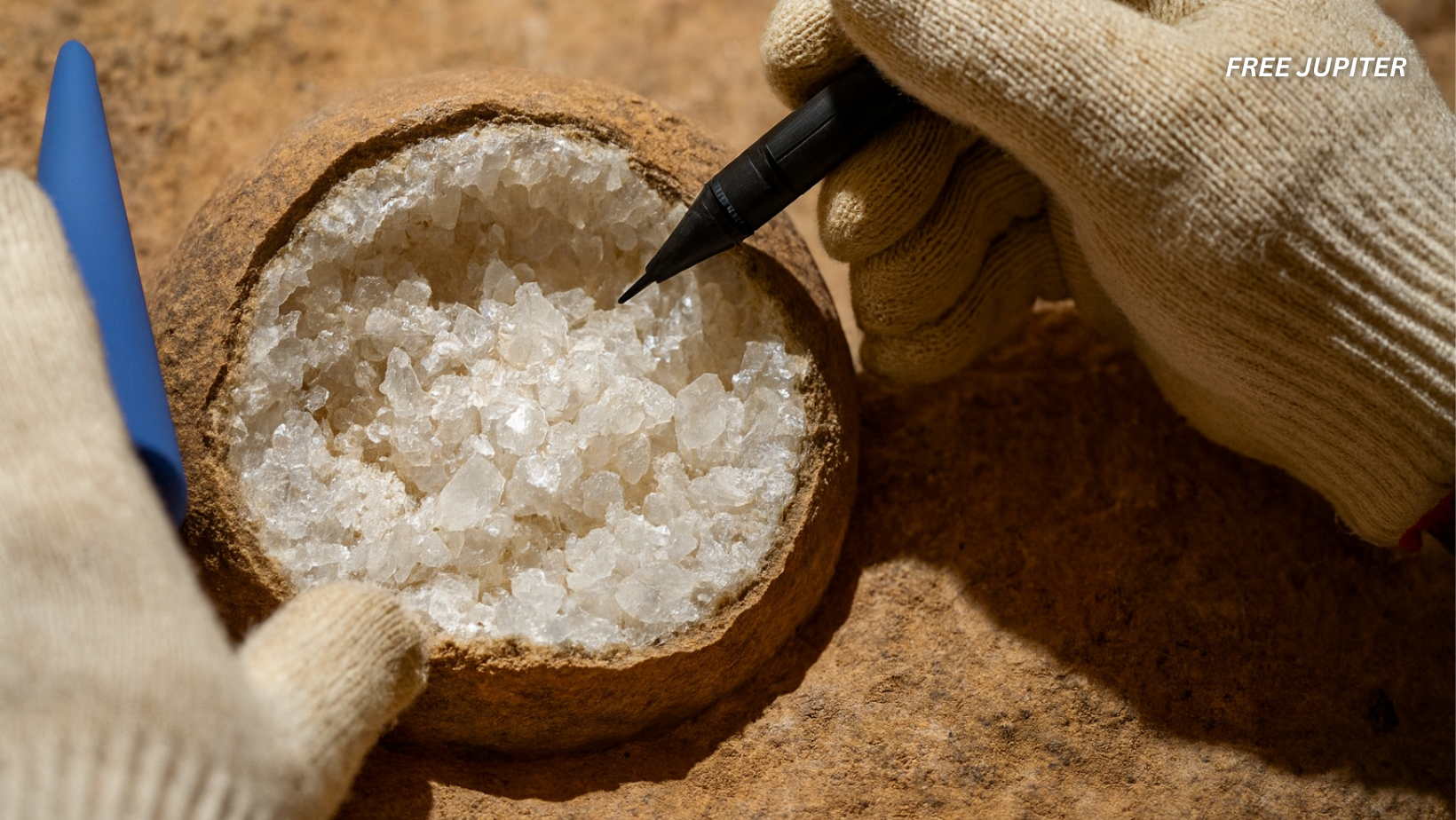When most of us picture dinosaurs, we think of towering giants like Tyrannosaurus rex, long-necked sauropods stretching into the sky, or maybe armored stegosaurs lumbering through forests. But some of the most fascinating stories about dinosaurs don’t come from their skeletons at all. Instead, they’re hidden inside something much smaller, almost fragile-looking — their eggs.
In central China, scientists recently discovered a clutch of 28 fossilized dinosaur eggs that are rewriting what we know about deep time. What makes these eggs remarkable isn’t just their preservation, but how scientists figured out their age. Using a method often called an “atomic clock,” researchers determined that these eggs are about 86 million years old, dating back to the late Cretaceous period. That’s tens of millions of years before the asteroid strike that ended the age of dinosaurs.
Cracking the “Atomic Clock”
The method used on these eggs is known as uranium-lead dating (U-Pb). This technique has long been a favorite of geologists for dating rocks and minerals, but applying it directly to fossilized eggs is groundbreaking. It works because uranium atoms naturally decay into lead atoms at a steady rate, almost like a built-in stopwatch running quietly inside minerals for millions of years.
To put it simply, think of uranium as grains of sand slowly falling in an hourglass. Over time, those grains turn into lead. By counting how much uranium remains and how much lead has built up, scientists can calculate how long the “timer” has been running. In this study, researchers used a precise laser to remove tiny flecks of eggshell, vaporized them, and then measured the uranium-to-lead ratio. The results were clear: the eggs date back roughly 86 million years.
86-Million-Year-Old Dinosaur Eggs in China: How Scientists Used Atomic Clock Dating
Read more: Enormous Dinosaur Fossil Discovered in China Could Challenge The Mighty T. rex
Why Eggs, Not Just Bones?
Traditionally, paleontologists figure out fossil ages by dating the rock layers surrounding them. This can work well when the fossils are trapped between volcanic ash layers or sediment deposits that can be directly measured. But there’s a problem: fossils don’t always stay where they first formed. Over millions of years, water, earthquakes, or shifting sediments can move remains, making them appear older or younger than they really are.
By directly dating the eggs themselves, scientists bypass this uncertainty. Instead of relying on the “neighborhood” of rocks, they’re looking at the eggs’ own built-in timeline. This method reduces guesswork and provides a much more precise way to connect dinosaur fossils with the environments and climates they lived in. It’s like finding a diary instead of relying on secondhand stories.
Meet the Egg Layers
As exciting as these eggs are, we still don’t know which dinosaur laid them. They’re classified under a group called Placoolithus tumiaolingensis, part of the Dendroolithidae family. Unlike skeleton-based classifications (T. rex, Velociraptor, etc.), egg-based categories are built on shell features, not bones. That means until skeletons are found alongside these eggs, the identity of their parents remains a mystery.
The eggs themselves are fascinating. They’re slightly squashed spheres, about the size of a grapefruit or small melon, ranging from 4.7 to 6.7 inches in length. Their shells are thin — less than a tenth of an inch thick — and unusually porous. This porousness may not just be a random trait. It could provide clues about how these dinosaurs adapted to the environment, especially as the late Cretaceous climate began to cool. Porous shells would allow more airflow for embryos, but they may also have increased the risk of drying out, showing the delicate balance these creatures had to maintain.
A Window Into Dinosaur Parenting
Eggs don’t just tell us about species; they also open windows into behavior. The Qinglongshan fossil reserve, where these eggs were found, contains more than 3,000 eggs across three sites. Many of them are preserved in three dimensions, meaning they kept their original shapes instead of being flattened over time. This suggests that entire nesting grounds were preserved — not just scattered, isolated finds.
This raises exciting possibilities. Did these dinosaurs return to the same nesting site every year, like sea turtles do today? Were the nests buried and left alone, or did parents stick around to guard them? By combining the age of the eggs with their physical features, scientists can begin piecing together how dinosaurs cared for their young and how those strategies evolved as climates shifted. It transforms eggs from simple fossils into records of parenting and survival strategies.
Beyond Qinglongshan: Why It Matters
While the eggs from Qinglongshan are important on their own, the bigger breakthrough is the dating method itself. Around the world, there are over 200 known dinosaur egg sites, but only a handful have been dated with high accuracy. Without precise dating, it’s difficult to compare nests from different locations or understand how dinosaur reproduction changed over time.
If U-Pb dating becomes more common in egg studies, paleontologists could finally build a chronological framework of dinosaur reproduction. For example, researchers could track whether shell thickness changed as climates cooled, or whether certain nesting styles disappeared before the extinction event. In short, this method may allow us to connect dinosaur reproduction to global events like climate shifts, volcanic eruptions, or even asteroid impacts.
Read more: Newly Discovered Dinosaur Species Rewrites The T. Rex Family Tree
Subtopic: Egg Studies Beyond Dinosaurs
Dinosaurs aren’t the only creatures to leave behind egg fossils. Paleontologists have uncovered eggs from ancient birds, reptiles, and even flying pterosaurs. Each discovery provides a different piece of the evolutionary puzzle, showing how reproduction adapted in different lineages.
For example, fossilized bird eggs from Mongolia suggest that early birds nested in colonies, similar to modern seabirds. Crocodilian eggshells found in South America point to wetter, tropical ecosystems that no longer exist in those regions. And pterosaur eggs discovered in China revealed that their shells were soft and leathery, unlike the rigid, porous shells of most dinosaurs. These comparisons highlight how egg structures evolved differently depending on an animal’s environment and lifestyle.
The Limits and Challenges
Despite its promise, U-Pb dating isn’t a universal tool. Not all fossils contain the right minerals to make this type of analysis possible. The Chinese eggs worked because they contained calcite, a form of calcium carbonate, which preserved uranium. Without it, the eggs would have been undatable using this method.
Even when calcite is present, the process is tricky. It requires advanced lab equipment, laser technology, and environments free from contamination. A single speck of outside material can skew the measurements, making results unreliable. This means that while the technique is revolutionary, it won’t be applicable to every fossil find — at least not yet.
A Bigger Picture of the Cretaceous
The late Cretaceous, when these eggs were laid, was a world in transition. Sea levels were high, flooding large parts of today’s continents. Vast inland seas cut across North America, and flowering plants were spreading rapidly. Meanwhile, in the oceans, massive predators like mosasaurs dominated.
But underneath this thriving ecosystem, subtle changes were happening. Global temperatures were slowly cooling, reshaping habitats and forcing species to adapt. The porous eggs of Qinglongshan may reflect one such adaptation, showing how even small features could mean the difference between survival and extinction. These eggs, then, are not just fossils — they are markers of life adjusting to a changing world.
Read more: Scientists Discover Dinosaur Cells That Survived For 68 Million Years
Final Thoughts
The discovery of these 86-million-year-old eggs — and the successful use of uranium-lead dating on them — marks an exciting turning point in paleontology. For the first time, eggs can be more than symbols of ancient reproduction; they can be precisely dated, offering reliable insights into when and how dinosaurs lived.
This breakthrough also highlights something important about science itself: innovation often comes from unexpected places. In this case, the idea came from researchers who normally study stalagmites in caves. By crossing disciplines, they uncovered a new way to study one of Earth’s most famous groups of animals.
If this method spreads, dinosaur eggs around the world could soon become some of the most valuable fossils for understanding deep time. They may reveal not just how dinosaurs raised their young, but also how they faced the challenges of climate, environment, and change — lessons that remain strikingly relevant today.
Featured image: GPT-5o Recreation.
Friendly Note: FreeJupiter.com shares general information for curious minds. Please fact-check all claims and double-check health info with a qualified professional. 🌱










